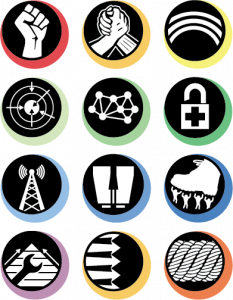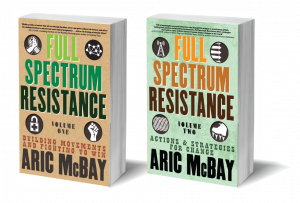In North America and around the world, more and more people are getting tired of the status quo on the left. Some of these are older people who yearn to recapture the fighting spirit they remember from years past. Some of them are young people already fed up with the obvious failures and timidity of established progressives in the face of global disaster. Some of them are working-class people tired of elected officials who promise change you can believe in, only to bow to corporate interests even as their economic greed weighs heavier and heavier on the poor. Some are part of a tradition of resistance who have reinvented their struggle in new forms like Black Lives Matter and Idle No More.
They all know that time is running out. And they are ready to fight.
So why do we fight? Why must we fight?
We fight because you can’t persuade a dictator, a sociopath, or a corporation. Mass exploitation is not a mistake or a misunderstanding, and evil is very profitable. As Frederick Douglass (escaped slave and abolitionist orator) famously said: “Power concedes nothing without a demand. It never has and it never will.”
Revolutionary author Gene Sharp understands this. Sharp has written extensively on how nonviolent action works, and his writings have been used in a number of actual revolutions. Sharp’s work makes it clear that nonviolent mass movements work by mobilizing political force, not by persuading the exploiters. He warns against the dangers of dialogue with those who would only use negotiations to distract or defuse resistance. He argues that in order to win, those fighting against authoritarians must “create a powerful internal resistance force.”16
Anarchist Michael Albert understands this, too. Examining what was lost in leftist culture since the 1960s, Albert explains: “Something went wrong with the slogan ‘speak truth to power,’ too. ‘Speak truth to power’ does not mean try and convince power by the logic of your truth. If it means that, it’s a slogan we should dump, because power doesn’t listen to logic. Power doesn’t give a damn about truth. The phrase just meant stand up with the truth and assert yourself with it. But somehow it got screwed up into ‘speak truth to power.’ Spend a lot of time trying to convince power of what the truth is. But that’s a total waste of time. Power only responds to raising social costs, to force, basically.”17
Force is not the same thing as violence. There are many different kinds of force. There is economic force: workers can go on strike, businesses can be boycotted, trade and transport systems can be disrupted, and economic systems rooted in justice can be built. There is political force: organized voting can be a form of political force, but political force can also include noncooperation with the establishment and the creation of oppositional political systems, from neighborhood assemblies to revolutionary congresses. There is social force: people can shun those responsible for atrocities, can impose social penalties on those who collaborate, and can organize social movements that value defiance and the upholding of human and ecological rights.
And there is the use of physical force. Mass noncooperation actions where people put their bodies on the line, from lunch-counter sit-ins to port blockades, are expressions of physical force. They physically impede bad things from happening. Strategies of physical force differ. They may be explicitly nonviolent. They may encourage self-defense. They may even accept physical counterattacks on those in power. In any case, successful resistance movements have the ability to use physical force. In history, this usually includes the capacity for violence, if only in self-defense.
It is especially important for those who embrace nonviolence to understand this point. As Gene Sharp writes: “Nonviolent action is a means of combat, as is war. It involves the matching of forces and the waging of ‘battle,’ requires wise strategy and tactics, and demands of its ‘soldiers’ courage, discipline, and sacrifice.”18 Nonviolent activist Barbara Deming argued: “The challenge to those who believe in nonviolent struggle is to learn to be aggressive enough.”19
In any case, when it comes to persuasion, there is little difference between a dictator, a sociopath, and a corporation. Indeed, many thinkers have pointed out that the modern corporation is essentially a sociopath, unmoored as it is from basic empathy and morality.
Those in power profit immensely by exploiting the working class and by stripping the Earth bare. The only way to stop them from doing this is to make exploitation—of people and of the planet—more costly than they can afford. This is one of the fundamental insights needed to undertake effective political action. Many resistance movements have spent (or wasted) decades trying to come to terms with this fact.
William Lloyd Garrison, renowned abolitionist and publisher, abandoned persuasion after many years of fruitless effort, saying in 1840: “There is not any instance recorded, either in sacred or profane history, in which the oppressors and enslavers of mankind, except in individual cases, have been induced by moral suasion, to surrender their despotic power and let the oppressed go free; but in nearly every instance, from the time that Pharaoh and his host were drowned in the Red Sea, down to the present day, they have persisted in their evil course until some sudden destruction came upon them, or they were compelled to surrender their ill-gotten power in some other manner.”20
On the opposite side, slaveholder James Hammond was equally clear: “If you distilled nectar from your lips and discoursed sweetest music . . . do you imagine you could prevail on us to give up a thousand millions of dollars in the value of our slaves, and a thousand millions of dollars more in the depreciation of our land?”21


